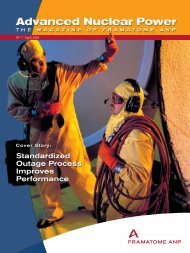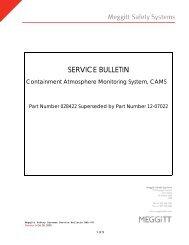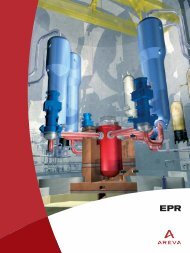Download - AREVA
Download - AREVA
Download - AREVA
- No tags were found...
You also want an ePaper? Increase the reach of your titles
YUMPU automatically turns print PDFs into web optimized ePapers that Google loves.
Industry InsightsNatural Gas Volatility – A Boonfor Nuclear Power?Historically the United States andBritain have relied on a diverseenergy portfolio – including nuclearenergy – for electricity generation. Butas both nations become increasinglydependent on natural gas to fuel theirpower plants, are they putting low-costreliable electricity at risk?US electricity generating capacitygrew phenomenally in the 1970s and1980s. “Every five years, the nationadded 10 percent capacity until the1990s,” says Matthew Simmons,chairman of Simmons & CompanyInternational. “In the first half ofthe 90s, we added 6 percent capacity.In the second half, we added 2percent.” The reason? Restructuringof the electric utility industry hadbegun. Uncertain about the future,power companies delayed investmentsin their systems, expecting to meetdemand by importing electricity boughtin deregulated markets. “Everyoneplanned to borrow everyone else’sreserve capacity,” says Simmons.It was an approach that worked –until the exceptionally hot, humidsummer of 1999. Record-breakingelectricity demand from an overloadedgrid caused blackouts and brownoutsin the eastern and central parts of thecountry. These events triggered whatSimmons calls “the most unbelievableexplosion of power plant construction.”By 2003, the country had addedapproximately 220,000 MW ofnatural gas-fired power plants – twicethe capacity that experts said wouldbe built by 2010. The fuel of choice –driven by the nation’s environmentalpolicies – was natural gas.Natural gas demand has been spurred,in part, by its increased use “as aclean-burning source of electric power,”Unlike fossil fuels, nuclear fuel is not subject toprice volatilityAlan Greenspan, chairman of the FederalReserve Board, told the Joint EconomicCommittee of Congress in May 2003.While demand has soared, supply hasremained essentially flat. The result?A looming natural gas shortage – atleast in the short term. Energy SecretarySpencer Abraham said in June 2003that demand for natural gas has risento levels “that are difficult to sustainunder current supply and productionconstraints.” Spiking natural gas pricesspell higher bills for electricity consumers.The country has every reason to beconcerned, says Simmons. As theeconomy expands – and it will – thenation will need more electricity.“There is no realistic scenario inwhich the US gross domestic productsignificantly expands without anexpansion in the use of electricity,”says Simmons. In the short term, thatelectricity can come only from naturalgas-fired power plants. In the longerterm, some of that electricity mustcome from new nuclear power plants.Source: Nuclear Energy Institute, Inc.Acknowledging that natural gas demand“is a real serious problem,” the Fed’sGreenspan said in May that “we oughtto be spending more time at leastlooking [at] and contemplating theissue of nuclear power.”The nation is already heavily dependenton its nuclear power plants, saysFrank Clemente, senior professor ofsocial science at Penn State University.“What has saved us so far is theworkmanlike job of the nuclear energyindustry in increasing productivity.”Since 1990, the availability of USreactors has risen from about 70 percentto more than 90 percent, resultingin increased electricity production –equivalent to 26 new 1,000 MWnuclear power plants.What’s more, nuclear-generatedelectricity has the lowest productioncost of all major forms of electricitygeneration – 1.71 cents/kWh in2002. Natural gas has the highest –4.06 cents/kWh in 2002. And nuclearplants aren’t subject to fuel cost.4 Advanced Nuclear Power N O 9 November 2003
















